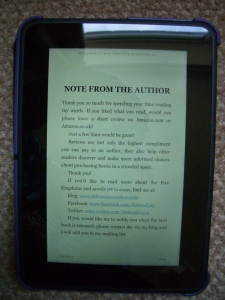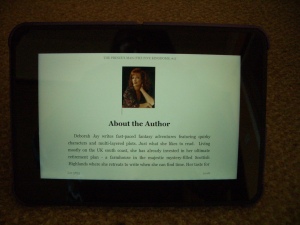In response to a question asked on my last post – a request for advice on gaining reviews for your book, I decided it was time to get my act together and repurpose a guest post I did for Debbie Young’s excellent blog OFF THE SHELF BOOK PROMOTIONS, as this includes one of my favourite pieces of advice on increasing your chances of getting reviews.
Debbie has been running a series exploring the author’s favourite marketing tips, and here is mine:
Add effective back matter to every book you publish, and keep it up to date
You may ask: what is back matter?
Well, its all the stuff that you add onto your book after you type, THE END.
That probably sounds a bit corny, as I don’t think too many people do that these days, but you know what I mean.
So what is effective back matter, and what exactly should you include?
At a minimum:
- a polite request to the reader to leave a review
- author bio and links, especially to your mailing list
- details of other books you have published
The beauty of back matter is that it is highly effective passive marketing – the only time you invest in it is when you initially set it up.
There will, of course, be updates needed periodically, but probably only each time you publish a new book, and the core of your back matter will be the same for each book, so you only need to write it once.
Example: Step 1 – NOTE FROM THE AUTHOR
 Ideally, the first thing a reader should see, following the end of the book proper, is a brief ‘thank you’ note from the author, with a request to leave a review. Something along the lines of:
Ideally, the first thing a reader should see, following the end of the book proper, is a brief ‘thank you’ note from the author, with a request to leave a review. Something along the lines of:
“Thank you so much for spending your time reading my words. If you liked what you read, would you please leave a short review on the site where you purchased it? Just a few lines would be great. Reviews are not only the highest compliment you can pay to an author, they also help other readers discover and make more informed choices about purchasing books in a crowded space. Thank you!”
If you tailor your ebook individually for a specific retailer, you can even insert a direct link to where you want your reader to leave a review.
Warning note: if you are uploading to Apple, take care not to mention other retailers by name anywhere in the book or they will decline to publish it.
Step 2 – AUTHOR BIO AND LINKS
Readers love to see what you look like, so put in your very best author photo, and a short bio, complete with all your social media links, your website address, and a direct link to your email list in case they loved your book so much they want to be kept updated on further releases.
Step 3 – details of other books
And finally, add a cover shot and blurb of any other books you’ve published, and details of where they can be found. This is the bit you will need to update each time you release a new book, but other than that, unless you change any of your personal links, the rest will be simple cut and paste into the back of every book.
Simples.
Step 4 – add a teaser
Aha – got you there! Didn’t mention this before, did I?
Well, it only really applies if the book in question is part of a series, at which point you may wish to include Chapter 1 of the next book, just to get the reader hooked so they will go and buy it immediately.
And that’s back matter. Not rocket science, but an effective, non-time-consuming method of marketing your other products and maximising the chances of gaining reviews.
If you’re interested in taking a look at the original feature, you can find it here.
Some authors take the view that this is akin to begging, but it has worked for me. It is noticeably the bigger selling traditionally published authors who hold this view, and I’m more interested in results than in maintaining any false sense of pride.
How about you? Do you include anything else, or have you had any other experiences with back matter?

























Another fab article Deb. And of course I’ve shared around town! 🙂
LikeLike
Thanks Deb 😀
LikeLiked by 1 person
[…] What sort of ‘back matter’ should your book contain? | deborahjay […]
LikeLike
Thank you Deborah for a great post! I’m Tweeting it today!
LikeLike
Thanks for dropping in and tweeting, Lilian 🙂
LikeLike
Hi Deborah – great to read a post on this important topic, and very helpful! I do add an About the Author, blog link and list of other titles at the back of my kindle books, plus gentle request for a review, but never thought about including a pic of me or next book cover. Good idea! I’m going to try this with the next one. I just started putting books out via Createspace and add all the kindle backmatter plus a teaser of sample chapters for other titles. Again, never thought about including pics. I struggle to get reviews so maybe this might help. Thanks for this. Will share!
LikeLike
We are a visually oriented species for the most part, and I think with so many readers using tablets or phones that support pictures these days, it’s another way to make a more personal connection. And as your book covers are your shop window, why not use them?
Good luck with increasing your review conversion rate – mine is certainly well above average, and I put a lot of that down to the inclusions in the end of my books.
LikeLike
so would you only use backmatter on Kindle versions?
LikeLike
No! Add it to ALL your books, even paperbacks. It can be a nuisance to update every book file each time you publish a new book, but you will find it well worth the effort.
Okay, so you can’t add clickable links in a paperback, and not all readers will support them either, but if you’ve provided them anyway, readers can always search the links online if they want to follow up either with you, as author, or another book.
It doesn’t matter what platform you publish on – this is about getting connections with your readers as well as gaining reviews. Plus, other platforms support reviews, and you want them wherever you can get them!
LikeLike
thank you, Deborah, not sure why month late seeing this, so I did add a note to the back, explaining how I came to do this and the use of a particular word and the backstory of the characters, so will see
LikeLiked by 1 person
[…] Something many of us see in books but don’t include in our own — and can be a nifty way of building an audience and getting reviews — is effective “back matter.” Sounds nasty, but it’s really pretty simple, and Deborah Jay delivers an excellent explanation with step-by-step examples for writing our own in her “What Sort of ‘Back Matter’ Should Your Book Contain?” […]
LikeLike
[…] “What Sort of Back Matter Should Your Ebook Contain?” on Deborah Jay […]
LikeLike
[…] “What Sort of Back Matter Should Your Ebook Contain?” on Deborah Jay […]
LikeLike
One additional detail of note. I’ve always included previews of the next book, but I’ve recently learned this is NOT always beneficial. Often, introducing the conflicts central to the sequel will disturb the successful resolution of the conflicts in the current book, leaving readers unsatisfied with the story. I noted this when my book, which sold well, didn’t receive ANY reviews. When I questioned readers, they reported being unhappy with the preview chapter. I’ve since yanked them from the story. Before including it, you need to consider whether it conflicts with the first book’s resolution.
LikeLike
What an interesting observation and a very valid point – thanks for adding to the post, Vincent.
I do think one should consider carefully whether to include such a teaser, depending on its content.
For me, so far, it has worked well, but I know I’ve been very annoyed when reading a really short book, to find that a large chunk of the page count is taken up by part of the next book – that seems disingenuous to me, and akin to ending on a cliff hanger, my pet hate!
LikeLike